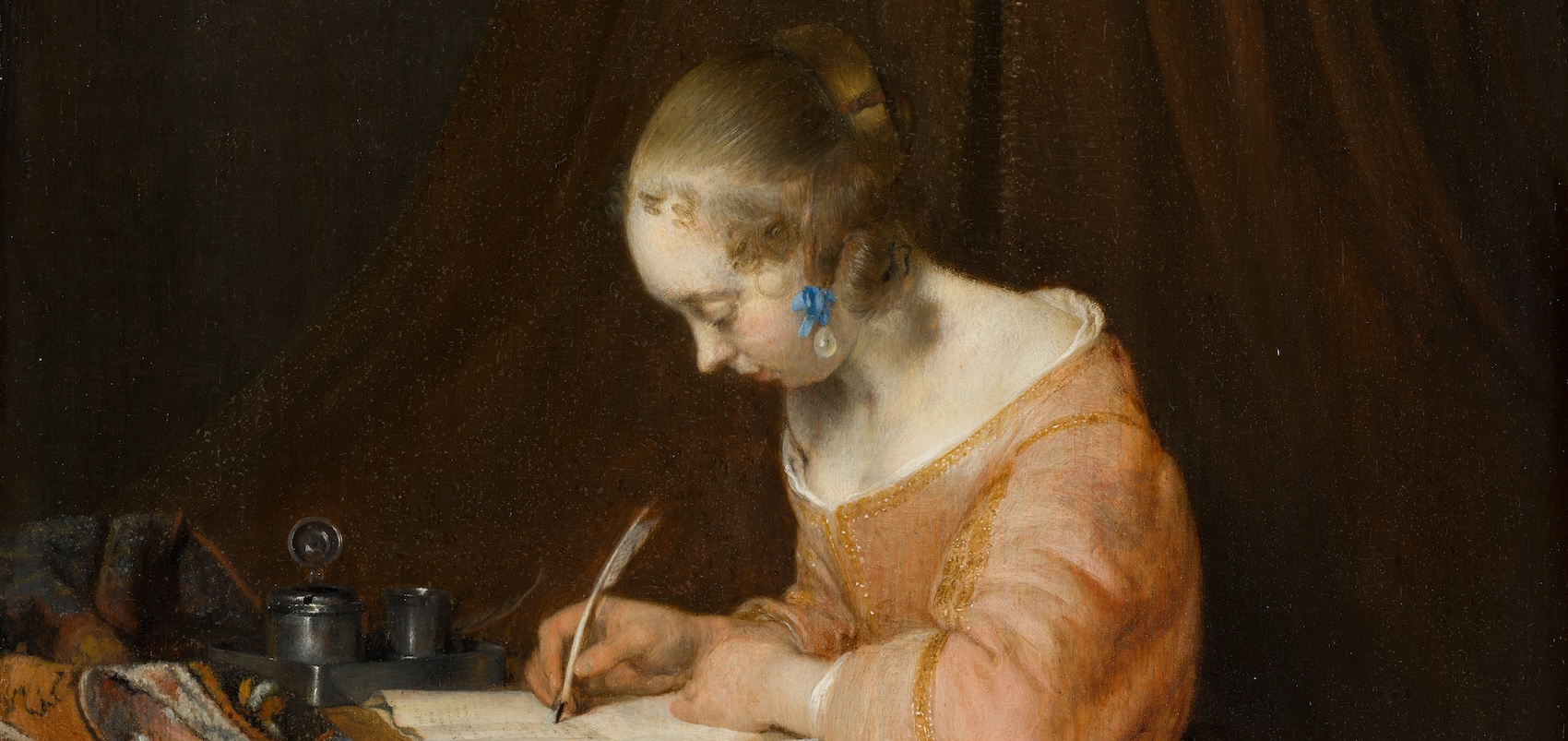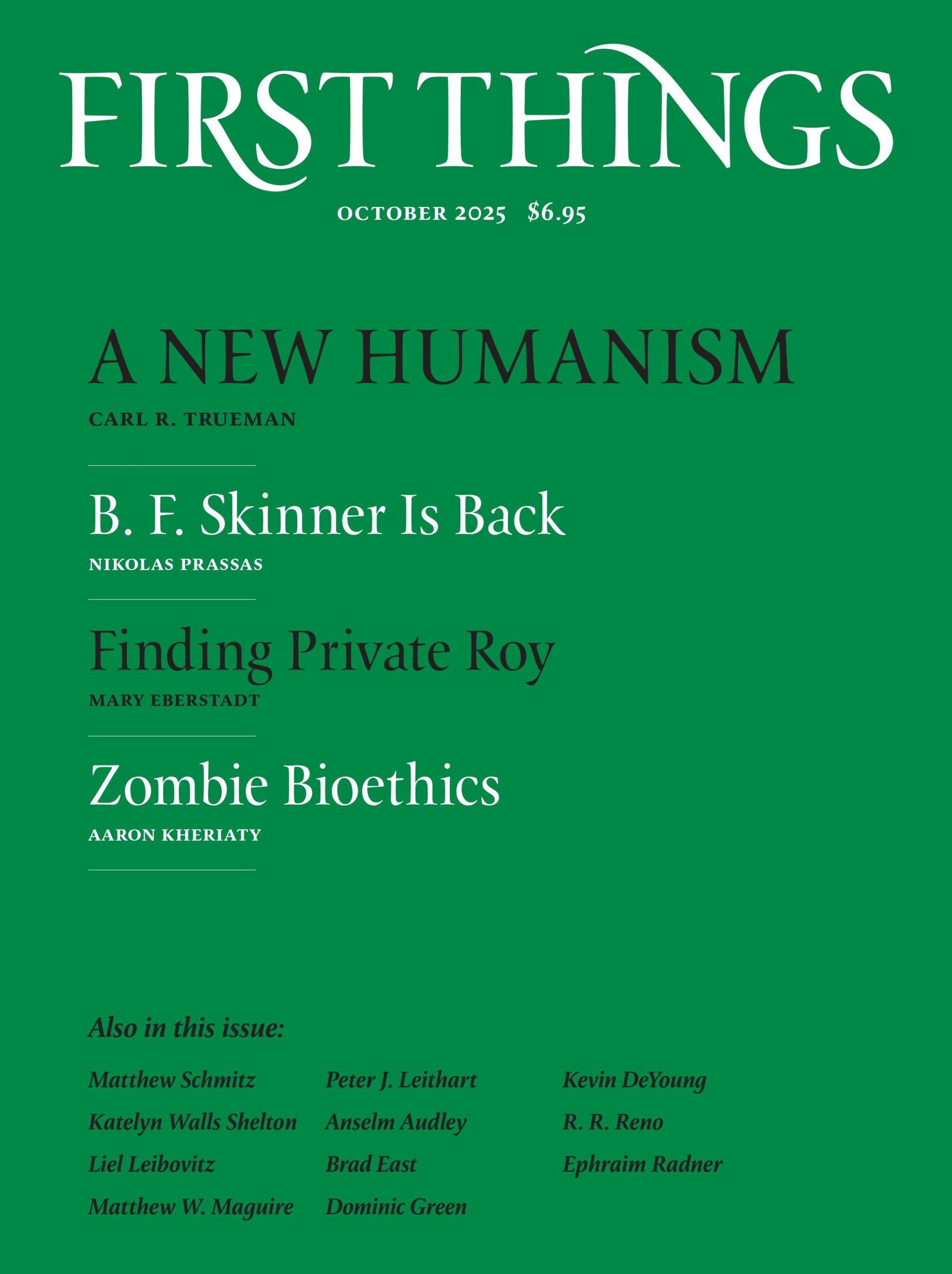
We welcome letters to the editor. Letters appear two issues after the article to which they are responding. Letters under three hundred words are preferred, and they may be edited for length and clarity.
Letters responding to articles published in this issue should be received by October 3 for publication in the December issue. Send them to [email protected].
Beauty in Print
I am writing not to address any particular article, but rather to register my concern about the portraits of regular columnists that have run for some years now since the redesign.
First Things stands for the good, the true, and the beautiful. If less than a dozen pieces of visual art appear within its covers—many of them staying the same from month to month—why are they not beautiful? Perhaps Messrs. Reno, Radner, and Leibovitz really are rather hideous. Perhaps one is to believe that Catholic, Protestant, and Jew are equally unattractive. If so, the image contradicts the word. While not necessarily saying that the portraits should look like they were done by Peter Paul Rubens, surely the whole tone of the magazine makes one think they should look classic, traditional, even reactionary—not like three of Andy Warhol’s bastards.
Rev. Caleb Nelson
gillette, wyoming
R. R. Reno replies:
First Things does stand for the good, the true, and the beautiful. In my estimation, the images of our regular columnists uphold that commitment. Consider the sketch of your humble editor. The slumping shoulders and wistful look in my eyes may lack complete verisimilitude, but in an artful way convey something of my character, which is not always combative. In all his images, the artist, Riccardo Vecchio, indulges in playful exaggeration of features. To my mind, this aesthetic underscores a quality of First Things that I cherish. We need to avoid the temptation to adopt the haughty confidence of those who possess timeless truths, a disposition that can make one cold, impersonal, and remote. A great deal of what we publish is bold and confident. But we are also experimental, seeking in these pages to envision a way to live faithfully in our strange and often inhospitable times, and in this endeavor we’re sure to make wrong turns, sometimes comically so, which means we need to have a sense of humor, especially about ourselves. This is especially true for the reactionary enterprise that Rev. Nelson rightly ascribes to First Things. Surely one of the most comical figures of the twentieth century was G. K. Chesterton, a splendid reactionary. In this regard, the portraits in our pages serve us well.
Embalming the Classics
I want to extend special thanks to James Hankins for his brilliant article, “Classical Renewal by Research” (June/July 2025). Professor Hankins gave words to something that I—as a recently graduated high schooler who has been immersed in a search for colleges over the past year—have often felt but not had the words to express. I long for an institution where I can find not just like-minded peers and faculty but also intellectual rigor and a research-based approach in my areas of interest. However, the unfortunate reality is that so many universities today seem to represent either one end or the other of the spectrum: either their humanities departments showcase what Hankins very aptly calls “bilge” (trans studies, queer justice, the politics of BIPOC, on and on) or else they are solidly rooted in the classics but totally lacking in excitement and, as Hankins put it, “intellectual vigor”; they are missing “a research community with proper values, methods, and goals.”
A woke-centered, progressive approach to the humanities is deplorable, but, in my mind, a researchless, passionless one is not much better. Nowadays, the most well-meaning conservatives often speak of “preserving” the classics/Western heritage, but this word, if I may say so, brings to mind the embalming of a dead body. I think Hankins would agree with me that the humanities are not a dead body but a living, exciting, constantly expanding entity—ancient, but with endless capability for the new. If we want to see a restoration of interest in the humanities, we need to make them seem exciting again (I say seem because, in my opinion, they already are) by re-introducing the research-based approach that Hankins recommends.
Isabella Yarbrough
manassas, virginia
Ecumenical Inclusion
Larry A. Smith’s “An Evangelical in Italy” touched this Catholic convert in several ways. Smith shows love for his Catholic friends as well as a respect for aspects of Catholic theology with which he does not agree. So far, so good. But I fear he misunderstands why he is not offered Communion in a Catholic Mass. “It was their choice, not ours.” This way of looking at the situation implies that, if they had so chosen, the priests could have offered the Eucharist. As well, had the Smiths chosen, they could have presented themselves and received Catholic Communion.
The Catholic reality looks different from that. To receive the sacrament literally means to be “in Communion,” meaning one in faith and worship. To receive Communion without being Catholic would therefore be an untruth. And for a Catholic Communion minister to knowingly give the sacrament to a non-Catholic would run the risk of placing the recipient afoul of 1 Corinthians 11:29. In Catholic theology, there is no choice involved for the Communion minister except the choice of disobedience.
Ecumenical relations are necessary, desirable, and in the case of the Smiths in Italy, fruitful. Their experience will be a model for others. But it’s important to see things from the viewpoint of the one with whom we disagree. To a Protestant, exclusion from Catholic Communion looks like inhospitality based on a rigid and senseless dogmatism. To a Catholic, it represents obedience, and to do otherwise borders on sacrilege.
Dcn. Bill Kussmaul
media, pennsylvania
Where We Build
Many thanks to Liel Leibovitz for explaining the mystery of Minecraft (“The Minecraft Effect,” June/July 2025). Now I’m not so critical of my wife’s fifteen-year-old nephew for devoting the bulk of his adolescence to this game. Perhaps Minecraft’s creative aspects are truly helping nourish the “unbeatable American spirit of wonder.” A point of contention, however, with Leibovitz’s remark about the “two curious brothers in North Carolina” who built “the world’s first airplane.” Wilbur and Orville Wright were from Dayton, Ohio, where their fascination with bicycles and other things mechanical drove them to design and build the first heavier-than-air flying machine. They packed it up and transported it to the huge sand dunes and windy shores of North Carolina for the first flight in 1903. Finding the Outer Banks to be logistically impractical, the Wright Brothers returned to Ohio and built an airfield in a cow pasture east of Dayton, where they continued their aircraft research and development. That cow pasture is now the site of Wright-Patterson Air Force Base, one of the largest aeronautical research facilities in the world. North Carolina might have a technical claim to “first in flight,” but the spirit and wonder of powered aviation was born and bred in Ohio.
David Thomas
dayton, ohio
Liel Leibovitz is correct in his assessment of town criers responding to A Minecraft Movie. I cannot remember the last film my nephews were insistent on seeing—and then seeing again! The boys bonded over their shared love for building in Minecraft, and we spent hours discussing the film and planning projects to work on together in the game. The film has not only sparked their passions but also strengthened their bond as cousins. They met other boys with a similar zeal for the game, and they’ve become friends both on the digital and physical dirt. I’m thankful that the passion these boys have has forged a small community for them, and I hope the naysayers in the culture war will chill out and notice that A Minecraft Movie isn’t trying to compel a narrative or a particular terminology. It is a lynchpin for boys to do what boys have always done: get together and have fun doing something they’re passionate about!
Christopher Fennell
milledgeville, georgia
Bibliocracy
As a confirmed and unapologetic bibliophile, I nodded in agreement with much of what Wessie du Toit offered (“The Future of Reading,” June/July 2025); however, I cringed when he declared that “we should be careful not to overstate the importance of reading for democracy, political liberalism, or other modern developments that we associate with intellectual autonomy and maturity.” As evidence, he goes on to say that bookaholics like me tend to downgrade the “active life” and may lack innovation and common sense. In fact, if we are not careful, the world could generate another Stalin, whose fanaticism and murderous ways can apparently be blamed in part on his reading too much Dostoevsky!
Du Toit’s solution, it appears, is to passively accept the dwindling population of readers and embrace the notion of a thriving literate minority that perhaps can better tend to the sacred nature of reading. This seems to me both fatalistic and flippant in its disregard for this vital practice. We should absolutely state and restate the importance of reading, not just to democracy, but to society and culture overall—to the pursuit of truth, beauty, and goodness in a world increasingly steering us in the opposite direction. As David Ulin in The Lost Art of Reading so aptly offers, “Reading, after all, is an act of resistance in a landscape of distraction. . . . We regain the world by withdrawing from it just a little . . . to discover our reflections in another mind. . . . We join a broader conversation, by which we both transcend ourselves and are enlarged.” Isn’t this something we want and desperately need for as many individuals as possible in order to flourish in a post-truth society fixated on the self-centered pursuit of all that is temporal and fleeting?
James L. Barge
mount st. joseph university
west chester, ohio
A Hope and a Prayer
In his otherwise excellent review (“Jesus After the Critics,” June/July 2025) of Elaine Pagels’s new book, Michael C. Legaspi omits any reference to John P. Meier. In the first book of his five-volume opus, A Marginal Jew: Rethinking the Historical Jesus: The Roots of the Problem and the Person, Meier states, “As in the first century, so today: no one’s Jesus—and no one Jesus—suits everyone.”
Legaspi correctly points out that “Pagels’s instinct to identify belief in the resurrection with something that goes beyond historical judgment—the suggestion that it comes down to faith—is difficult to gainsay.” In every Catholic liturgy, after the consecration, the celebrant says, “The mystery of faith,” and the congregation may respond, “We proclaim your death, O Lord [historical statement], and profess your resurrection [faith statement], until you come again [eschatological statement].”
Spencer F. Stopa
mesa, arizona
It’s sadly amusing to people of faith to consider the efforts of eminent scholars to find the historical Jesus. It is not that such contributions aren’t greatly appreciated—especially from someone as respected as Professor Pagels, whose criticism, unlike much modern biblical scholarship, leaves room for belief. But faith is a gift that can be lost, and this has apparently happened to her. It’s a forest where Jesus is found, and the trees look so much different from inside the forest. No matter how the evidence may seem to contradict the gospel message, it has the ultimate limitation of running up against the revealed truth, which God for his own reasons has decided not to reveal to the wise and learned.
You might ask, what’s the big deal? Some have faith and some are scholars. But on this subject, the irony is so rich. Some know hardly anything about the historical Jesus, and yet they know him intimately. Others know almost everything about the historical Jesus—and know only the historical Jesus.
Joseph Mirra
new york, new york

